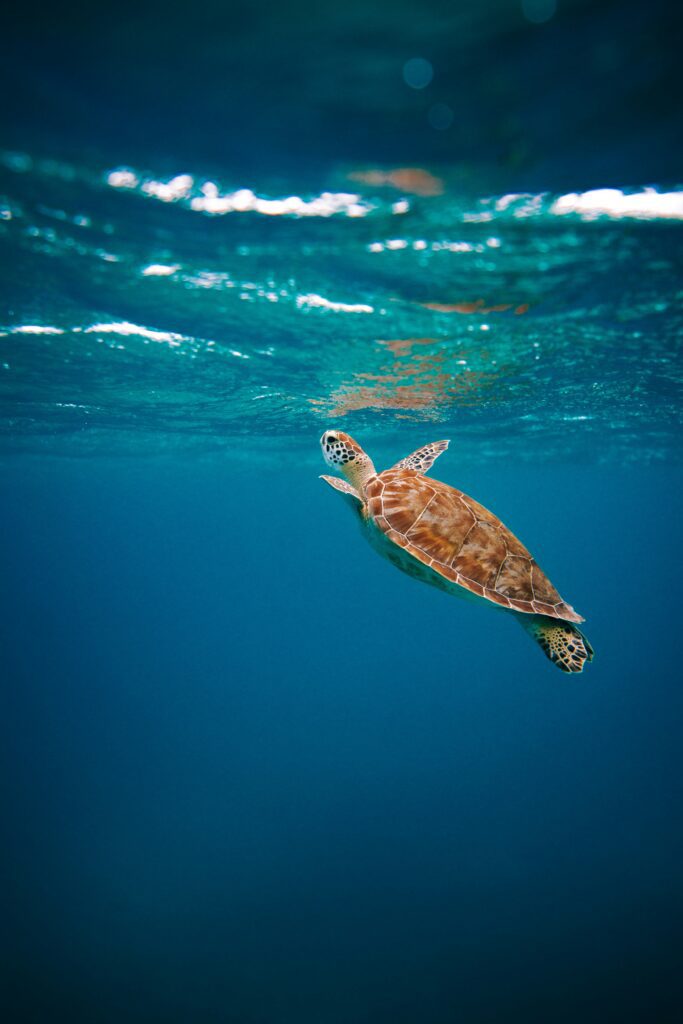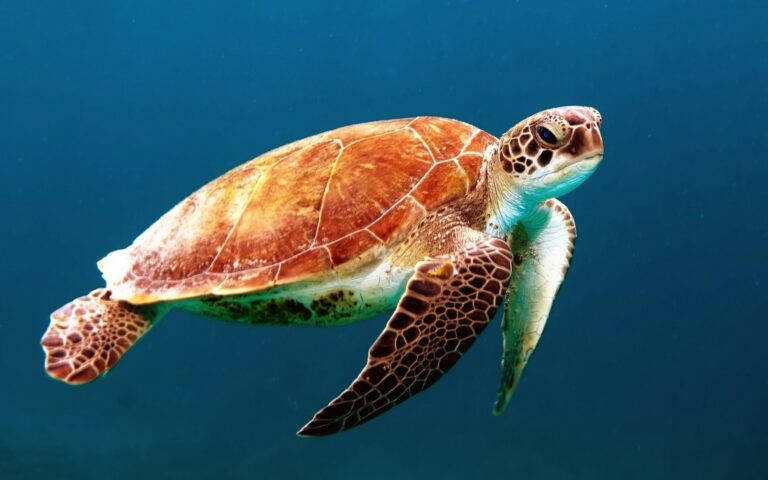Sea turtles have traversed the world’s oceans for millions of years, embodying resilience and adaptability. As ancient navigators of the seas, these magnificent creatures have survived countless challenges, from natural predators to changing climates. However, in the modern era, sea turtles face an unprecedented array of threats, primarily due to human activities. In this article, we’ll explore the remarkable journey of sea turtles, the perils they confront today, and the urgent need for conservation efforts to ensure their survival.
Origins and Evolutionary History
Sea turtles are ancient creatures with a fascinating evolutionary journey that stretches back over 100 million years. Their origins can be traced to the late Jurassic period, making them one of the oldest reptile groups on Earth. Fossil evidence suggests that the earliest ancestors of modern sea turtles appeared around 120 million years ago, evolving from terrestrial turtles that returned to the ocean. These early sea turtles likely shared many characteristics with their modern counterparts, such as streamlined bodies and flipper-like limbs for swimming.
Diverse Species and Habitats
Today, there are seven recognized species of sea turtles, each with its own unique characteristics and adaptations. These species inhabit a wide range of marine environments, from tropical and subtropical seas to cooler temperate waters. The green sea turtle, for example, is commonly found in coastal areas and seagrass beds, while the loggerhead turtle prefers deeper offshore habitats. Leatherback turtles, on the other hand, are highly migratory and can be found in both tropical and subpolar regions, traveling thousands of miles between feeding and nesting grounds.
Adaptive Characteristics for Oceanic Life
Sea turtles have evolved a variety of adaptations that allow them to thrive in their oceanic habitats. One of the most notable adaptations is their streamlined body shape, which reduces drag and enables efficient swimming. Additionally, their limbs have evolved into powerful flippers, ideal for maneuvering through the water with precision and speed. Sea turtles also possess specialized glands that allow them to excrete excess salt, enabling them to maintain proper salt balance in their bodies despite living in a highly saline environment.
Another crucial adaptation is their ability to undertake long migrations between feeding and nesting grounds. Some species of sea turtles travel thousands of miles across open ocean, relying on magnetic cues, ocean currents, and celestial navigation to navigate accurately. These remarkable adaptations have allowed sea turtles to colonize virtually every major ocean basin on the planet, making them one of the most widely distributed marine reptiles.
Life Cycle and Behavior
Sea turtles exhibit fascinating life cycles and behaviors that are essential to their survival in the marine environment.
Nesting Habits and Migration Patterns
One of the most remarkable aspects of sea turtle behavior is their nesting habits and long-distance migration patterns. Female sea turtles return to the beaches where they were born to lay their eggs, often traveling thousands of miles across open ocean to reach their nesting grounds. These nesting migrations are crucial for the survival of the species, as they ensure that sea turtles return to suitable beaches to lay their eggs and continue the life cycle. Once the eggs are laid, they are left to incubate in the sand, and after a period of several weeks, the hatchlings emerge and make their way to the ocean.
Feeding Behaviors and Diet Preferences
Sea turtles exhibit a diverse range of feeding behaviors and diet preferences depending on their species and habitat. Some species, like the green sea turtle, are herbivores, feeding primarily on seagrasses and algae found in coastal areas. Others, such as the loggerhead turtle, are carnivores and feed on a variety of prey including jellyfish, crustaceans, and mollusks. Leatherback turtles have a unique diet consisting mainly of jellyfish, which they locate using their specialized vision and feeding adaptations. These different feeding behaviors play a crucial role in shaping marine ecosystems, as sea turtles help maintain the balance of marine food webs by controlling populations of their prey species.
Role in Marine Ecosystems
Sea turtles play a vital role in marine ecosystems as both predators and prey. As predators, they help control populations of prey species, preventing them from becoming overabundant and disrupting the balance of the ecosystem. Additionally, sea turtle eggs and hatchlings provide a valuable food source for a variety of predators, including birds, mammals, and even other reptiles. Furthermore, sea turtles contribute to nutrient cycling in marine environments through their feeding and nesting activities, enriching coastal habitats with essential nutrients. Overall, sea turtles are keystone species in marine ecosystems, and their conservation is critical for maintaining the health and stability of these fragile habitats.

Modern Threats to Sea Turtles
Sea turtles face numerous modern threats that jeopardize their survival and contribute to population declines worldwide.
Habitat Destruction and Coastal Development
One of the most significant threats to sea turtles is habitat destruction and coastal development. As human populations continue to expand, coastal areas are increasingly developed for residential, commercial, and industrial purposes. This development often results in the destruction and degradation of important nesting beaches and feeding habitats for sea turtles. Coastal construction projects, such as seawalls, jetties, and beachfront resorts, can disrupt nesting activities and block access to critical nesting sites. Additionally, the alteration of coastal ecosystems through dredging, sand mining, and beach nourishment projects further exacerbates the loss of suitable habitat for sea turtles.
Pollution: Plastics, Oil Spills, and Chemical Contaminants
Pollution poses a significant threat to sea turtles, with plastics, oil spills, and chemical contaminants being particularly harmful. Plastic pollution, in the form of discarded fishing gear, plastic bags, and microplastics, poses a grave threat to sea turtles through ingestion and entanglement. When sea turtles mistake plastic debris for food and ingest it, they can suffer from intestinal blockages, malnutrition, and death. Oil spills are another major concern, coating sea turtles’ bodies and habitats with toxic substances that can impair their ability to swim, feed, and reproduce. Chemical contaminants, such as pesticides, heavy metals, and industrial pollutants, accumulate in sea turtle tissues and can disrupt their hormone levels, immune function, and reproductive health.
Overfishing and Bycatch
Overfishing and bycatch are significant threats to sea turtle populations, particularly in areas where commercial fishing activities overlap with sea turtle habitats. Sea turtles often become unintentional bycatch in fishing gear such as trawl nets, longlines, and gillnets, leading to injury, drowning, and death. The depletion of fish stocks due to overfishing can also indirectly impact sea turtles by reducing their food sources and altering marine ecosystems. Sustainable fishing practices and the implementation of bycatch reduction measures are essential for mitigating these threats and conserving sea turtle populations.
Climate Change and Sea Level Rise
Climate change poses a growing threat to sea turtles and their habitats, with rising temperatures and sea levels impacting nesting beaches and altering ocean conditions. Higher temperatures can skew the sex ratios of sea turtle hatchlings, leading to imbalances in populations and reducing genetic diversity. Sea level rise can inundate nesting beaches, erode coastal dunes, and submerge important nesting areas, forcing sea turtles to relocate or reducing available nesting habitat. Additionally, climate-related phenomena such as increased storm frequency and intensity can destroy nests, displace hatchlings, and disrupt nesting activities. Mitigating the effects of climate change through emissions reduction and adaptation strategies is crucial for safeguarding the future of sea turtles and their habitats.
VIDEO CREDITS NOP
FAQs
Q. What are sea turtles?
A. Sea turtles are marine reptiles that have been around for millions of years, with ancestors dating back to the time of dinosaurs. They are well-adapted to life in the ocean and can be found in various habitats worldwide.
Q. How many species of sea turtles are there?
A. There are seven recognized species of sea turtles: the leatherback, loggerhead, green, hawksbill, Kemp’s ridley, olive ridley, and flatback.
Q. What are some of the main threats facing sea turtles today?
A. Sea turtles face numerous threats, including habitat destruction, pollution, climate change, bycatch in fishing gear, poaching, and ingestion of marine debris such as plastic.
Q. Why are sea turtles important to the marine ecosystem?
A. Sea turtles play a crucial role in maintaining the health of marine ecosystems. They help control jellyfish populations, maintain the health of seagrass beds and coral reefs, and provide nutrients to beaches through their eggs and carcasses.
Q. How can individuals help protect sea turtles?
A. Individuals can contribute to sea turtle conservation efforts by reducing plastic use, properly disposing of trash, supporting sustainable fishing practices, participating in beach clean-ups, respecting nesting sites, and supporting organizations dedicated to sea turtle conservation.
Conclusion
Sea turtles represent a living link to our planet’s ancient past, embodying resilience, grace, and mystery. Yet, their survival hangs in the balance as they navigate treacherous modern waters. The threats they face are not insurmountable, but they require concerted efforts from individuals, communities, and governments worldwide. By understanding the profound significance of sea turtles and the urgent need to protect their habitats, we can ensure that these ancient mariners continue to grace our oceans for generations to come. It’s time to rally together, to safeguard their future and preserve the wonders of our marine world.
UP NEXT
Ocean Conservation and the Preservation of Coastal Mangrove Forests



